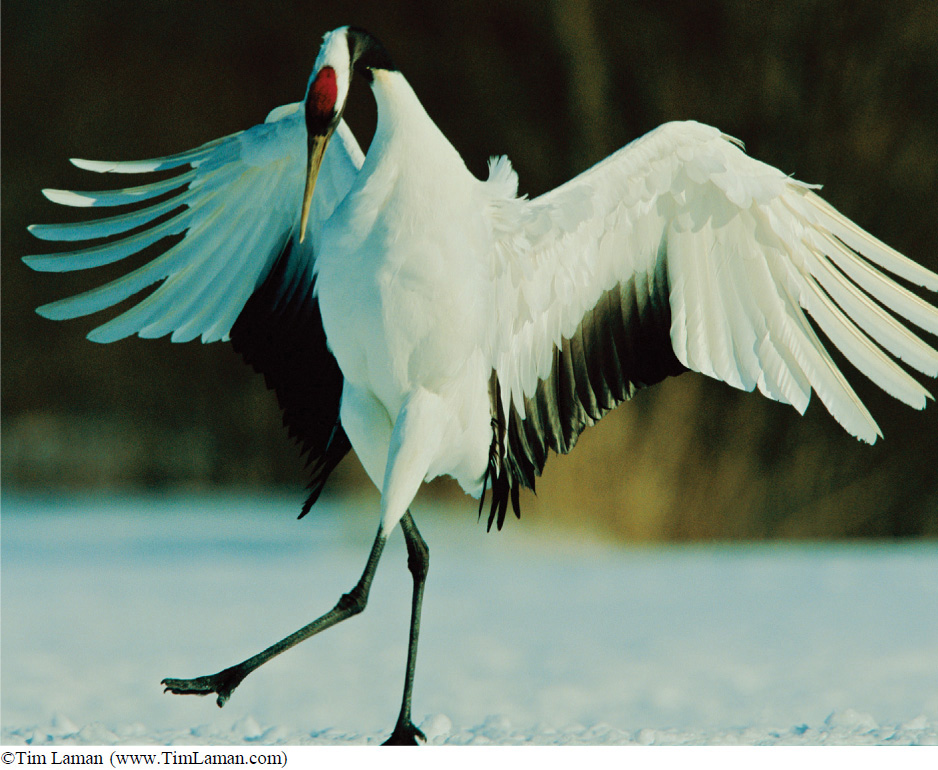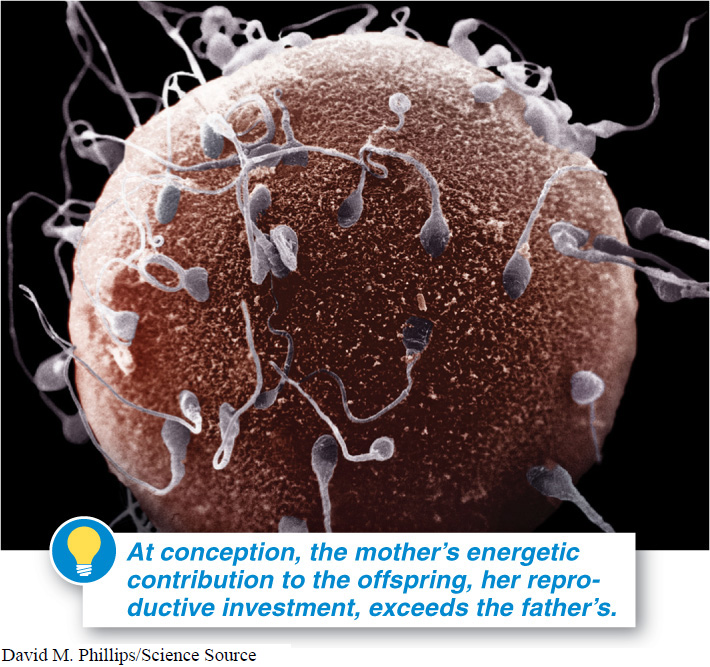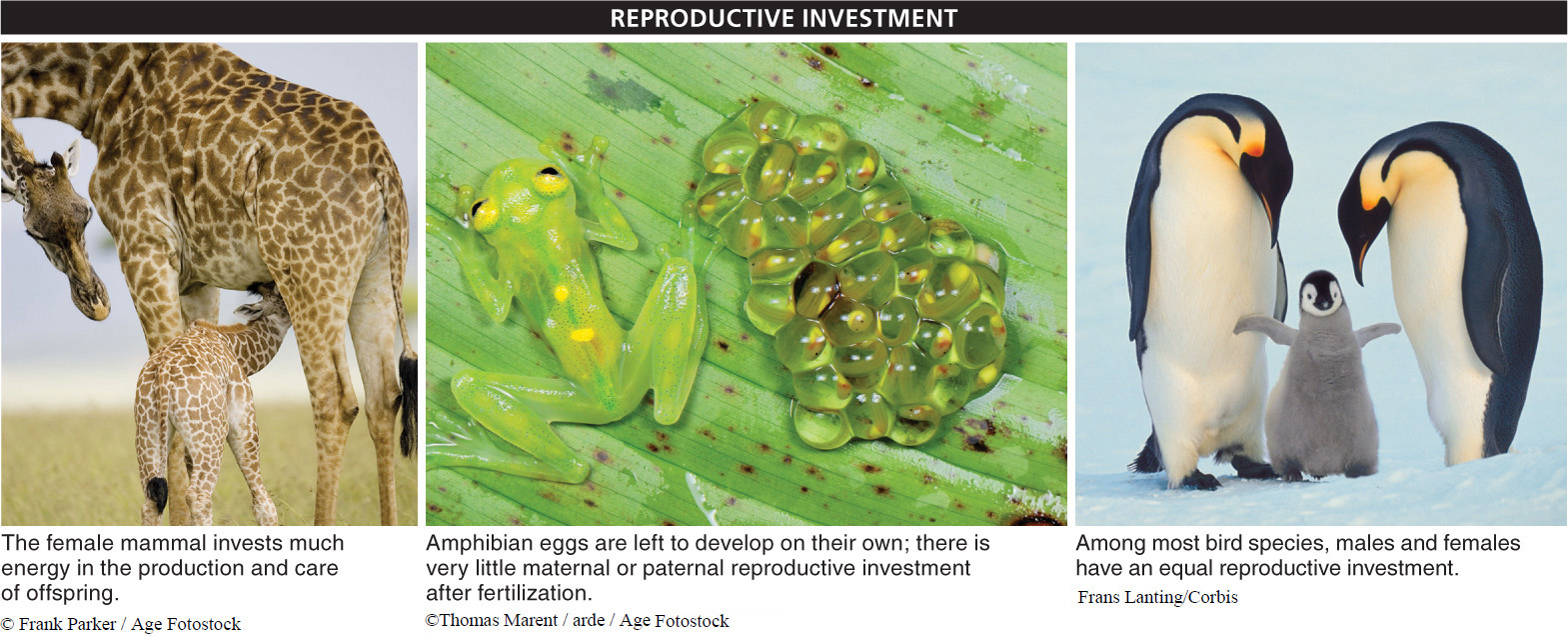
As we’ve seen, many behaviors have evolved that influence the ways in which animals interact with each other, reducing conflict and sometimes leading to cooperation. One aspect of life that necessarily involves interaction—
How many babies can a woman produce over her lifetime? The number is probably higher than you would guess: a Russian woman had 69 children (in 27 pregnancies). But even this high number is greatly exceeded by the 888 offspring produced by one man (Emperor of Morocco from 1672 to 1727). The large difference between the number of offspring that can be produced by females and males is less surprising. Among other species of mammals, the pattern is consistent: a male elephant seal can produce 100 offspring, while the maximum produced by a female over her lifetime is 8; a male red deer can produce 24 offspring, while the maximum produced by a female is 14. Here we examine the physical differences between males and females and how they lead to differences in sexual behavior.
The very definition of “male” and “female” hinges on a physical difference between the sexes. Recall from Chapter 6 that in species with two distinct sexes, a female is defined as the sex that produces the larger gamete, while a male produces the smaller gamete (FIGURE 9-16). At conception, the mother’s material and energetic contribution to the offspring—

383
This discrepancy in size and quantity between the sperm produced by a male and the eggs produced by a female sets the stage for evolutionary developments that magnify this initial difference in reproductive investment. For starters, the difference in the number of gametes that males and females can produce means that males have the potential to produce many, many more offspring than females. Put another way, a male’s total reproductive output, the lifetime number of offspring he can produce, tends to increase as the number of females he is able to fertilize increases. A female, on the other hand, does not generally increase her reproductive success by mating with additional males beyond the first (FIGURE 9-17).

Why do males usually compete for females rather than the opposite?
Because additional matings usually lead to greater increases in reproduction (and fitness) for males, selective pressure has resulted in the evolution of some differences in male and female reproductive behavior. For males, the most effective way to maximize their reproductive success often is to find and gain access to mating opportunities with additional females. For females, an effective way to maximize their reproductive success often is to put more effort into parenting and less effort into mating.
When it comes to putting more effort into parenting, two physical differences that can exist between males and females are particularly important. First, in species with internal fertilization, which includes most mammals, fertilization takes place in the female. The offspring also grow and develop within the female’s body. The amount of energy females invest in reproduction is therefore much greater than males’ investment. Females’ reproductive investment also limits their reproductive output; they can be pregnant only once at a time.
A second important physical difference between females and males occurs in the mammals: lactation takes place in females and not in males (with a very small number of exceptions). In these species, then, nurturing during both pregnancy and lactation can be accomplished only by the female. This difference in reproductive investment has led to the evolution of some very different reproductive behaviors in males and females.
Although the gamete size difference is consistent across all animals (i.e., the egg is always bigger and energetically more costly to make than the sperm), the physical differences between the sexes in the early nurturing (i.e., gestation and feeding) of offspring can vary considerably across animal species. In some cases, male and female investments become more nearly equal after fertilization. In birds, for example, before emergence of the chicks, much of the development of the fertilized egg is external: the female lays an egg, but either the male or the female can protect and incubate the developing embryo. Further, birds do not lactate. Once hatched, the chicks must be fed—
Accordingly, in many bird species, the maximum lifetime reproductive output of males and females is similar. In the kittiwake gull, for example, the largest number of offspring produced by a male is 26, while for a female the number is 28. External fertilization in fish and amphibian species further reduces the reproductive investment of the female—

384
Another profound consequence of internal fertilization is that a male cannot be 100% certain that any offspring a female produces are his progeny. Because it is possible for a female to mate with multiple males, any of whom could be the father, male mammals and birds will always have some degree of paternity uncertainty.
In the next few sections, we’ll continue to explore how the physical differences between males and females in reproductive investment, along with paternity uncertainty, have led to the evolution of differences in male and female reproductive behavior.
TAKE-HOME MESSAGE 9.10
In mammals and many other animals, there are important physical differences between males and females relating to reproduction. Fertilization usually takes place in the female. Lactation takes place only in the female. And in species in which fertilization occurs inside the female, males cannot be certain that offspring are their progeny. These physical differences have led to the evolution of differences in male and female reproductive behavior.
How is a female mammal’s reproductive investment commonly greater than a male’s investment?
Eggs require a greater energy investment than sperm. Likewise, the growth and development of offspring, which occurs within the female’s body, and also lactation require a significant energy investment by the female.